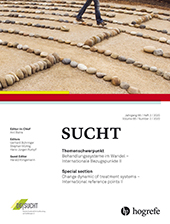Evidence Production for Psychosocial Treatment of Substance Use Problems
Lost in Translation?
Abstract
Abstract.Aims: In the article at hand we intend to discuss to what extent hitherto efforts towards standardization and quality assurance have been able to achieve stability concerning the production of evidence, and whether an actual evidence-based practice for psychosocial interventions for alcohol and drug problems is anywhere truly in the making. Methods: To explain several methodological inadequacies we make use of a perspective commonly referred to as the actor-network theory (ANT). This is characterized by a strong interest in detailed analysis of how an innovation or an idea is transformed due to interaction with its situated and specific conditions. The empirical material is taken from four earlier studies of our own hands. Results: We have given examples of how an unsystematic handling of different control group designs can lead to serious misinterpretations of intervention effects. The same goes for researcher allegiance, the use of different types of criteria in order to rank different types of evidence, unmotivated restrictions on the inclusion of evidence in a given systematic review, or as in the case of several US clearinghouses, to use extremely weak criteria when discriminating between what is evidence-based and what is not. Conclusions: We suggest that all of these shortcomings are directly or indirectly related to translations, modifications or neglect to adhere to methodological rules intended to produce a reduction of biases and increase standardization
Zusammenfassung.Zielsetzung: Der vorliegende Artikel diskutiert, inwieweit die bisherigen Bemühungen um Standardisierung und Qualitätssicherung Stabilität bei der Herstellung von Evidenz erreichen konnten und ob tatsächlich eine evidenzbasierte Praxis für psychosoziale Interventionen bei Alkohol- und Drogenproblemen im Entstehen begriffen ist. Methode: Zur Erklärung einiger methodischer Unzulänglichkeiten wird die actor-network-Theorie (ANT) herangezogen. Diese legt ihr Hauptaugenmerk auf eine detaillierte Analyse der Art und Weise, wie eine Idee oder Innovation durch die Interaktion mit deren situativen und spezifischen Gegebenheiten umgewandelt wird. Das empirische Material stammt aus vier eigenen früheren Studien der Autoren. Ergebnisse: An Beispielen wurde gezeigt, wie ein unsystematischer Umgang mit verschiedenen Kontrollgruppendesigns zu schwerwiegenden Fehlinterpretationen von Interventionseffekten führen kann. Das Gleiche gilt für die Schulenzugehörigkeit von Forschern, die Verwendung verschiedener Arten von Kriterien, um verschiedene Evidenzstufen zu erreichen, unmotivierte Einschränkungen bei der Aufnahme von Evidenz in einen systematischen Review oder, wie im Fall mehrerer US-Clearingstellen, die Verwendung extrem schwacher Kriterien bei der Unterscheidung was evidenzbasiert ist und was nicht. Schlussfolgerungen: Es kann vermutet werden, dass die genannten Mängel direkt oder indirekt mit Übersetzungen, Modifikationen oder der Missachtung von methodischen Regeln zusammenhängen, die Verzerrungen reduzieren und eine erhöhte Standardisierung bewirken sollten.
Literature
American Psychiatric Association (2006). Practice Guideline for the Treatment of Patients with Substance Use Disorders.Second Edition. Washington, D. C.: American Psychiatric Association.Australian Government (2009) Guidelines for the Treatment of Alcohol Problems . Prepared by Haber, P., Lintzeris, N., Proude, E., & Lopatko, O. for Australian Government, Department of Health. The University of Sidney, Publication Number: P3-5625(2006) Mot en evidensbaserad praktik? Om färdriktningen i socialt arbete. [Towards an evidence based practice?.On the direction of development in Social Work]. Socialvetenskaplig Tidskrift, 13, 99–113.
(2014) The pursuit of evidence-based practice: Comparisons of three guidelines on psychosocial interventions for alcohol problems. Nordic Studies of Alcohol and Drugs, 31, 271–288.
(2001) Implementing evidence-based practice in mental health settings. Psychiatric Services, 52,179–182.
(2015). Disclosure of researcher allegiance in meta-analyses and randomised controlled trials of psychotherapy: A systematic appraisal. British Medical Journal Open, 5, e007206.
(2004). Evidence based guidelines or collectively constructed ”mindlines stud”? Ethnographic y management of knowledge primary care. BMJ, 329,1013.
(2007). The devil is in the details. Examining the evidence for ‘proven’ school-based drug abuse prevention programs. Evaluation Review, 31(1), 43–74.
(1997). Closing the gap between research and practice. British Journal of Psychiatry, 171, 220–225.
(2014). Evidence based medicine: a movement in crisis? BMJ; 348:g3725. doi: 10.1136/bmj.g372.
(2009). The social construction of ‘evidence-based’ drug prevention programs. A reanalysis of data from the drug abuse resistance education (DARE) program. Evaluation Review, 33(4), 396–414.
(2005). Why most published research findings are false. PLoS Medicine, 2(8): e124. doi: 10.1371/journal.pmed.0020124
(2017). Compared with what? An analysis of control group types in Cochrane and Campbell reviews of psychosocial treatment efficacy with substance use disorders, Addiction, 110, 420–428.
(2014). Procedures and claims among US evidence-producing organizations: the case of the Incredible Years programme. Evidence & Policy, 10, 61–67.
(2016). Effects of psychosocial interventions Inon behavioural problems in youth: a close look at Cochrane and Campbell reviews. International Journal of Social Welfare, 26,177–187.
(2007) Knowledge translation. Closing the evidence-to-practice gap. Annals of Emergency Medicine, 49, 355–363.
(2009). Cochrane reviews used more rigorous methods than non-Cochrane reviews: Survey of systematic reviews in physiotherapy. Journal of Clinical Epidemiology, 62(10), 1021–1030.
NBHW (2007). Nationella riktlinjer för missbrukarvården [National Guidelines for the treatment of alcohol and drug abusers]. Stockholm: Socialstyrelsen.NICE (2011). Alcohol-use disorders: diagnosis, assessment and management of harmful drinking (high-risk drinking) and alcohol dependence. Clinical Guideline. National Clinical Practice Guideline 115. National Collaborating Centre for Mental Health commissioned by the National Institute for Health & Clinical Excellence. Great Britain: Stanley L. Hunt Ltd(1999). The researcher’s own therapy allegiances: A “wild card” in comparisons of treatment efficacy. Clinical Psychology: Science and Practice, 6, 95–106. 1371/journal.pmed.0020124
(1996). Evidence based medicine: what it is and what it isn’t. BMJ, 312(7023), 71–72.
(2006). Will the real evidence practice please stand up. Breif Treatment and Crisis Intervention, 4,137–154.
U. S. Department of Education ,Institute of Education Sciences ,What Works Clearinghouse (2011).Children Classified as Having an Emotional Disturbance intervention report: The Incredible Years. Retrieved from http://whatworks.ed.gov.(2013). Observations of evidence-based medicine in general practice. Perspectives on Medical Edducation, 2(4), 196–208.
(2001) The great Psychotherapy debate. Milton Park: Routledge, Milton Park.



